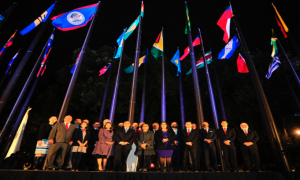By: Romney Manassa

Ambassadors and Representatives of the OPANAL Member States in the Plaza de las Tres Culturas, Tlatelolco, Mexico City (OPANAL.org)
Unbeknownst to most Americans, Mexico played a pivotal role in keeping our country—and arguably the entire world—safe from nuclear conflict. Following the Cuban Missile Crisis in 1962, the country launched a campaign to denuclearize Latin America, which was the first attempt at denuclearization in a vast and populous region, let alone one contested by nuclear superpowers.
A series of Mexican-led international conferences culminated in the 1967 Treaty for the Prohibition of Nuclear Weapons in Latin America and the Caribbean—popularly known as the Treaty of Tlatelolco, after the Mexico City district where it was drafted. It prohibits the “testing, use, manufacture, production or acquisition by any means whatsoever of any nuclear weapons” and the “receipt, storage, installation, deployment and any form of possession of any nuclear weapons.” It also establishes the Mexico-based “Agency for the Prohibition of Nuclear Weapons in Latin America and the Caribbean” (Spanish: OPANAL), which monitors compliance.
With Cuba’s ascension in 2002, every nation in the Western Hemisphere, except the U.S. and Canada, are parties to the Treaty. An Additional Protocol ratified by France, the Netherlands, the U.S., and the U.K., bans these nations from transferring nukes to their territories in the region. Another Additional Protocol ratified by the five official nuclear powers—France, China, Russia, the U.S., and the U.K.—forbids transporting or stationing nukes anywhere in Latin America and the Caribbean. These agreements are still honored to this day.
Aside from having likely prevented another nuclear crisis, the Treaty of Tlatelolco directly inspired similar treaties and initiatives worldwide—and can still do so today. Amid renewed U.S.-Russian nuclear rivalry, heightened hostility between India and Pakistan, and tensions regarding Iranian and North Korean nuclear ambitions, the Treaty offers a proven model of multilateralism and conflict resolution, especially by “middle powers:” less powerful states, like Mexico, which leverage their subsequent resourcefulness and diplomatic acumen towards goals too big or complex for one country—even a superpower like the U.S.—to tackle on their own.
By virtue of lacking the “hard power” of wealth or military might, middle powers are more engaged with international law and institutions, which provide a more leveled playing field through which to exercise influence. As Mexico’s bold denuclearization initiative demonstrates, middle powers can be adept at wielding “soft power” tools like summits, intergovernmental organizations, and treaties to address global problems. Their comparatively weaker status makes them ideal intermediaries between mutually distrustful larger powers, while their greater numbers allow for more effective coalition building and diplomatic pressure.
In an increasingly multipolar and complicated world, the value of middle powers cannot be underestimated. From helping draft a new arms control treaty between rival powers, to hosting talks before tensions flare up, states big and small, and rich and poor, can decisively play to their strengths—even if it is behind closed doors or under our radar.




